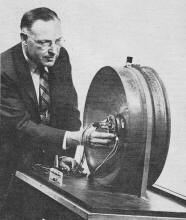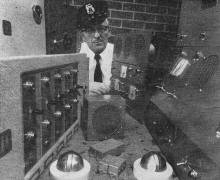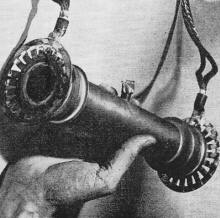Recent Developments in Electronics
|
|
The reflected-beam kinescope (RBK) held high hopes for large video displays with shallow depths. A traditional cathode ray tube (CRT) is as deep from front to back as the width of the display, which means, as anyone who has owned a CRT television or computer monitor knows, a lot of space is required to accommodate a large display. Evidently the RBK never panned out as a manufacturable product. Its "inside-out" configuration resulted in a CRT that looks like someone reached through the front, grabbed the tail end, and pulled it back through the front. If you have access to the IEEE document database, a paper by H.B. Law and E.G. Ramberg titled, "The Reflected-Beam Kinescope," covers the subject more thoroughly. In other 1960 news was a large photovoltaic array, a high voltage ferroelectric converter for satellites, an electric power generator that used rocket exhaust, and a magnified radar scope. Recent Developments in Electronics A radically new type of thin picture tube that promises increased brightness, detail, and compactness in military and commercial radar systems is under development by RCA. The experimental tube, known as a reflected-beam kinescope, has a viewing surface 21 inches in diameter and a total length of only 10 inches. The phosphor screen is over the curved rear inner surface instead of at the tube face. The electron beam approaches the transparent face of the tube, which acts as an "electron mirror" to reflect the beam back to the phosphor. The new tube can display TV pictures but with only one-quarter the efficiency of conventional TV picture tubes.
Detection devices shown here are used with the new integrated building protection and security system introduced by Minneapolis-Honeywell. Included are fire and smoke detector heads, tamper-proof magnetic switches to windows, electronic noise and motion detectors, capacitance-type electronic fencing, and many others. Any of the devices can be tied in with the new system's centralized control console. In all instances of alarm, a guard at the console receives both an audible alarm (horn, buzzer, bell) and visual warning (push-button switch lights up).
The world's largest solar energy converter, "Big Bertha," converts sunlight into electricity by means of over 7,800 silicon solar cells, similar to those used to power instruments in U. S. earth satellites. "Big Bertha" was used recently for the first time to power a door-opening device during the dedication of the new $2-million Hoffman Semiconductor Center in El Monte, Calif. It has been installed permanently on the Center's roof to provide electricity for the Center's solar energy exhibits. The solar cells are attached to a 4- by 8-foot panel. An automatic tracking device keeps the panel faced toward the sun for maximum efficiency. Ten individual panels in the array can be connected in various combinations to provide 6 to 60 volts at currents from 0.5 to 5 amps.
A ferroelectric converter, developed by ITT laboratories, can produce high voltages directly from the warming power of the sun or other heat source. Unlike solar cells, which depend on light to produce low-voltage d.c., the converter relies on temperature changes alone to produce high-voltage a.c. by means of special ceramic coatings.
Advanced antennas which meet the extremely wide band requirements for electronic warfare weapons are shown below. These were displayed at the formal opening of a major addition to Sylvania's Electronic Defense Laboratories at Mountain View, Calif. Antennas having a 30:1 bandwidth have been built here.
New General Instrument device permits air traffic controller to pick out on radar screen anyone "blip" within 200 miles and identify it exactly without communicating with plane's crew. Aircraft radar beacon sets up identifying numbers on indicator at right.
This electronic system with no moving parts converts the heat of a rocket exhaust directly into electric power to run the steering controls and electronic equipment of the missile. System consists of RCA thermionic generator tube in the shape of a hollow cylinder which fits like a sleeve over the flame tube attached to a Thiokol solid-fuel rocket motor in a special test mount. Heat from the burning fuel is converted directly to electricity, which is carried through wire leads to measuring equipment used during tests.
Posted June 20, 2018
|
|







